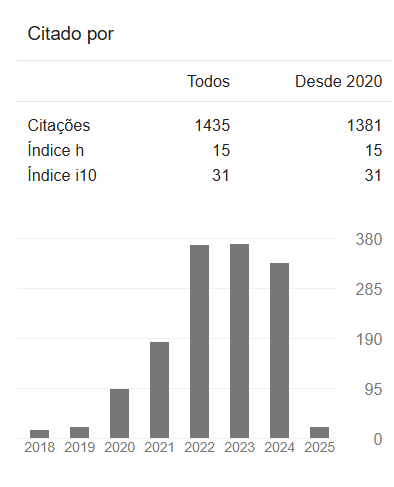MATHEMATICS TEXTBOOKS OF THE 9TH GRADE OF ELEMENTARY SCHOOL: AN ANALYSIS IN THE LIGHT OF THE REFERENCE MATRIX OF THE SAEB TEST
DOI:
10.23926/RPD.2023.v8.n1.e23046.id688Keywords:
Textbook analysis, Saeb Teste, Descriptors of mathematics, Analysis of textbook questionsAbstract
This study presents the results of a research that aimed to analyze how the questions presented in the mathematics textbooks of the 9th grade of elementary school of PNLD20202023 are related to the descriptors of the Saeb Test. The research methodology used a qualitative approach, based on document analysis, which were textbooks of mathematics of the 9th grade of PNLD20202023. It was found that the textbooks analyzed, mostly, have already, in their list of questions, a significant number of items related to the descriptors of the reference matrix of the Saeb Test. However, such questions are not, for the most part, of the Saeb Test type, i.e., they do not follow the form of multiple choice. Almost all of the textbooks analyzed do not have all the descriptors of the Saeb Test, a fact that certainly can be harmful to teachers and students who use these textbooks and have to take the Saeb Test.
Downloads
Metrics
References
BIFFI, Lorena Carolina Rosa. História da matemática em livros didáticos do ensino médio: um olhar a partir do manual do professor. 2018. 122 f. Dissertação (mestrado em Educação para a Ciência e a Matemática) - Universidade Estadual de Maringá, 2018, Maringá, PR. Disponível em: http://repositorio.uem.br:8080/jspui/handle/1/5808. Acesso em: 28 dez. 2022.
BRASIL. Guia Digital PNLD2023: obras didáticas objeto 1. Brasília: Ministério da Educação, Secretaria de Educação Básica, Fundo Nacional de Desenvolvimento da Educação. 2021. 41 p.
BRASÍLIA (DF). Edital n. 01 de 2021. Edital de convocação para o processo de inscrição e avaliação de obras didáticas, literárias e pedagógicas para o programa nacional do livro e do material didático - PNLD 2023.
CAVALCANTE, José Luiz; RODRIGUES, Rochelande Felipe. FAHRENHEIT 451: CONSIDERAÇÕES SOBRE O LIVRO DIDÁTICO DE MATEMÁTICA E SUA ANÁLISE À LUZ DA ABORDAGEM ANTROPOLÓGICA DO DIDÁTICO. Revista Paranaense de Educação Matemática, [S. l.], v. 11, n. 25, p. 194–216, 2022. Disponível em: https://periodicos.unespar.edu.br/index.php/rpem/article/view/5169. Acesso em: 28 dez. 2022.
COLEMAN, James Samuel. Desempenho nas escolas públicas. In: BROOKE, Nigel; SOARES, José Francisco (Org.) Pesquisa em eficácia escolar: origem e trajetória. Belo Horizonte: Ed. da UFMG, 2008. p.26-32.
GATTI, Bernadete Angelina. O professor e a avaliação em sala de aula. Estudos em Avaliação Educacional, n. 27, p.98-114, jan-jun/2003
GONÇALVES, Franciéllem Roberta. Um estudo sobre a presença e a influência das crenças de professores de Matemática ao utilizar o Livro Didático. Dissertação (Mestrado em Educação Matemática) Universidade Estadual Paulista (Unesp), Instituto de Geociências e Ciências Exatas, Rio Claro/SP, 2022.
INEP, Matriz de Referência Matemática Saeb. Disponível em: http://smeduquedecaxias.rj.gov.br/nead/Biblioteca/Gest%C3%A3o/IDEB/portal.inep.gov.br/web/saeb-e-prova-brasil/downloads.html. Acesso em 13 de outubro de 2021.
INEP, Sistema de Avaliação da Educação Básica (Saeb). Disponível em: https://www.gov.br/inep/pt-br/areas-de-atuacao/avaliacao-e-exames-educacionais/saeb. Acesso em 21 de julho de 2022.
Instituto Nacional de Estudos e Pesquisas Educacionais ‘Anísio Teixeira’ – INEP. Press kit SAEB 2021. Brasília, 2022. Disponível em: chrome-extension://efaidnbmnnnibpcajpcglclefindmkaj/https://download.inep.gov.br/saeb/resultados/press_kit_saeb_2021.pdf. Acesso em 05 de novembro de 2022.
KRUG, Carbone Bruno Schmidt; NOGUEIRA, Clélia Maria Ignatius. Ideias base de função e função afim: analisando o livro didático do Ensino Médio. Revista de Ensino de Ciências e Matemática, [S. l.], v. 13, n. 1, p. 1–18, 2022. DOI: 10.26843/rencima.v13n1a01. Disponível em: https://revistapos.cruzeirodosul.edu.br/index.php/rencima/article/view/3117. Acesso em: 28 dez. 2022.
MANTOVANI, Katia Paulilo. O Programa Nacional do Livro Didático-PNLD: impactos na qualidade do ensino público. Dissertação (Mestrado em Geografia Humana) USP, São Paulo 2009.
QUARTIERI, Marli Teresinha. GIONGO, Ieda Maria. REHFELDT, Márcia Jussara Hepp. SCHMITT, Fernanda Eloisa. ZIEGLER, Janaina de Ramos. Atividades presentes nos livros didáticos de matemática e questões da Prova Saeb: implicações para a prática pedagógica. Revista de Extensão, Santa Maria, v. 3, n. Especial, p. 616– 621, 2016.
SÁ, Pedro Franco de; SANTOS, Maria de Lourdes Silva; RIBEIRO, Andreia da SilvaMarques. SAEB E PNLD: dissonâncias e implicações das avaliações de larga escala no contexto educacional brasileiro. Revista Prática Docente (RPD), Confresa/Mato Grosso, v. 5, n. 2, p. 673-699, mai/ago 2020.
Downloads
Published
How to Cite
Issue
Section
License
Copyright (c) 2024 A Revista Prática Docente tem o direito de primeira publicação

This work is licensed under a Creative Commons Attribution-NonCommercial 4.0 International License.
Authors who publish in this journal agree to the following terms:
- Authors retain the copyright and grant the journal the right of first publication, with the paper simultaneously licensed under the Licença Creative Commons Attribution allows the sharing of the work with acknowledgment of authorship and initial publication in this journal.
- Authors are authorized to take additional contracts separately, for non-exclusive distribution of the version of the work published in this journal (e.g. publish in institutional repository or as a book chapter), with acknowledgment of authorship and initial publication in this journal.











